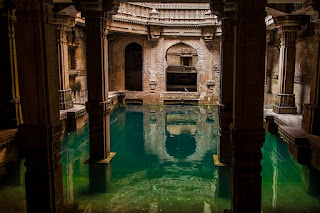About place :
The flamboyant 15th-century stepwell, has lost only little of its grandeur over the last few centuries. Till date, the intricate carvings on the pillars that support the five storeys are mostly intact; the beams work as pit stops for pigeons flying in and out and the structure still leaves jaws dropped for swarms of people. The step-well represents the Indo-Islamic fusion architecture that percolated through the many stepwells of the period. There are some fascinating features of the vav that make this an important emblem of superior architecture. The opening in the ceilings above the landing allows light and air to enter the octagonal well, but direct sunlight never touches the steps except at noon. It is said that the temperature inside the well is six degrees cooler than outside. The stepwell has three entrances. The stairs lead to an underground storey, which has an octagonal opening on top. The walls are covered in ornamental carvings with mythological and village scenes. Some of them include Ami khumbor (a pot that contains the water of life) and the Kalp vriksha (a tree of life) carved out of a single slab of stone. There is a belief that the small frieze of Navagraha (nine-planets) towards the edge of the well protects the monument from bad omens.
Brief History:
The stepwell was built by Mahmud Begada in 1411, to commemorate Queen Rudabai, wife of Veersinh, the Vaghela chieftain. It served both a utilitarian and spiritual purpose for the people around. A number of people from villages around once filled water from this stepwel
Tags:
Stepwell


This comment has been removed by the author.
ReplyDeleteAmazing place 😍
ReplyDelete